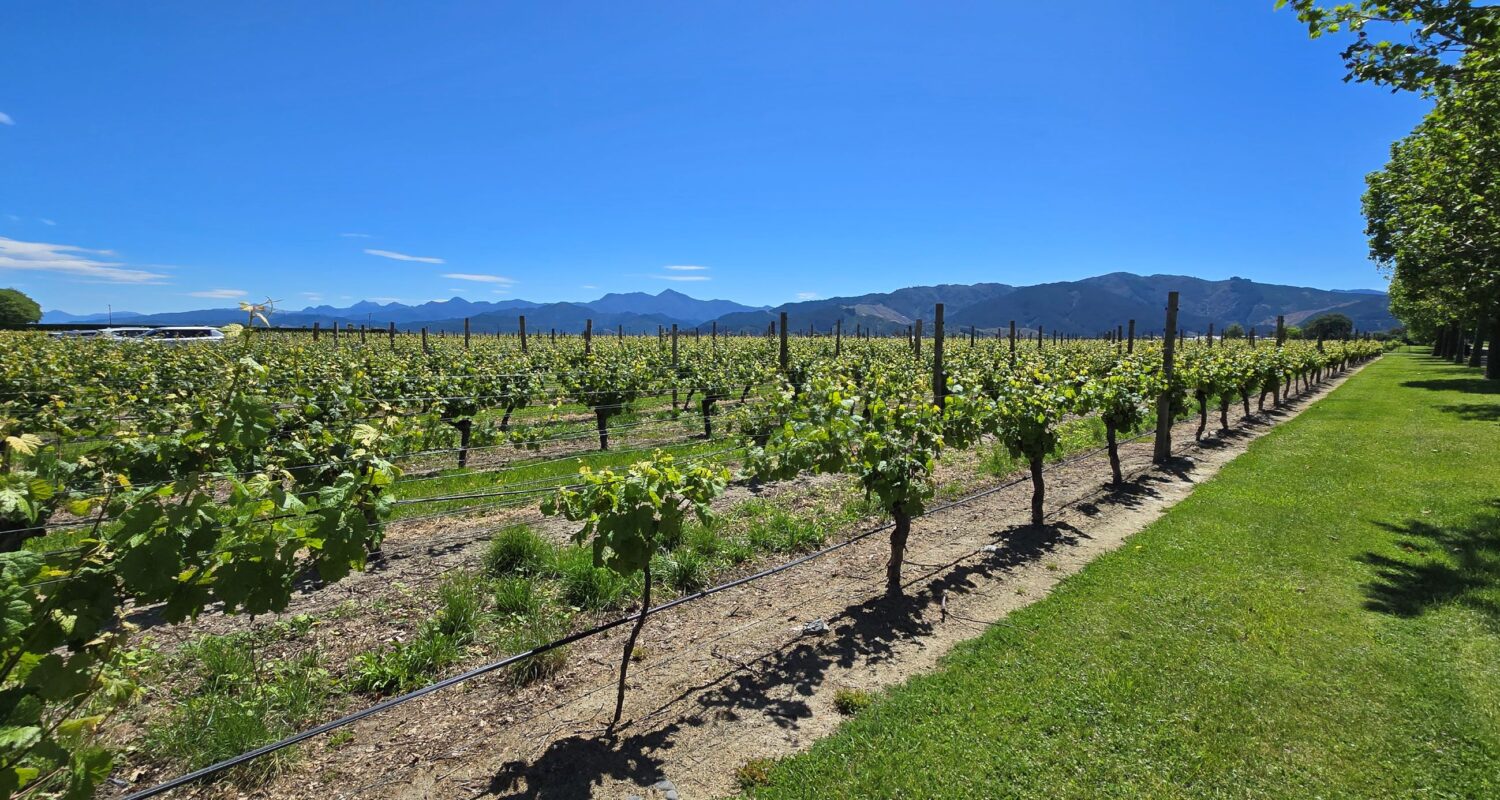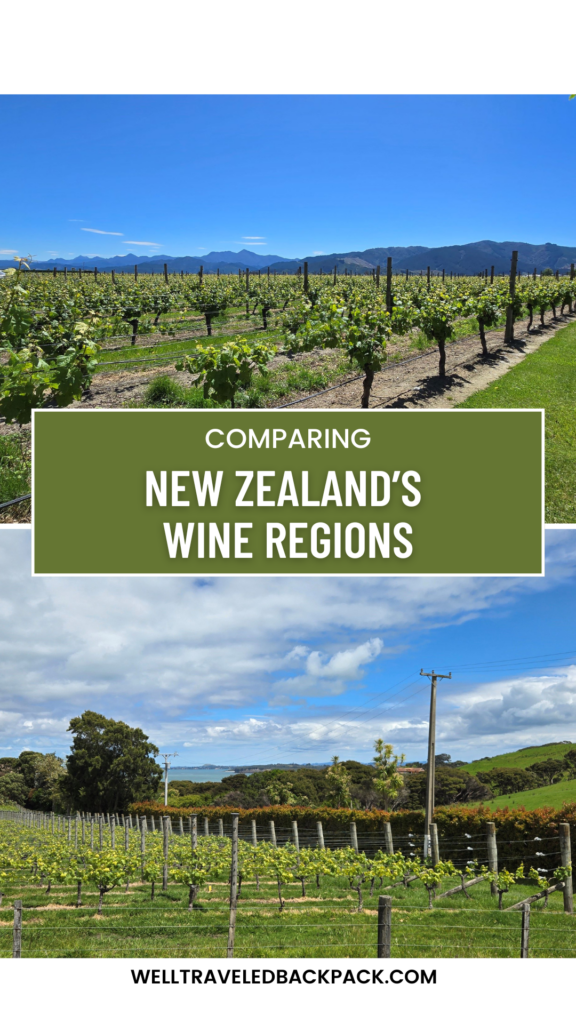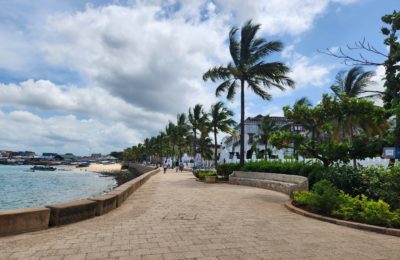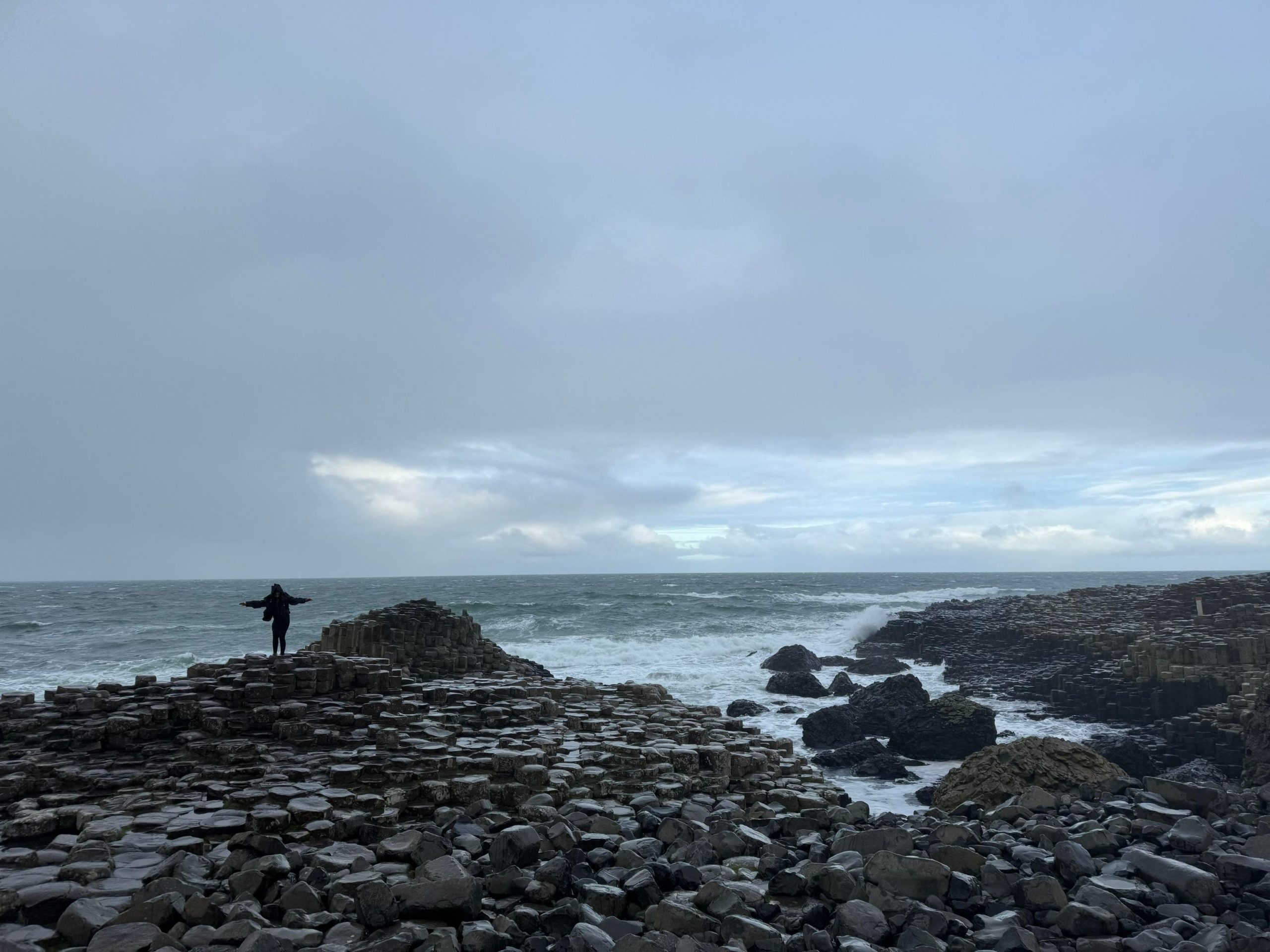It’s no secret that Aotearoa / New Zealand is one of the best wine destinations in the world. The island has so much diversity in weather and landscape. Many places never get too hot or too cold, creating the perfect climate for wine grapes. There are several New Zealand wine regions.
If you enjoy drinking wine at all, I highly recommend visiting at least one wine region in New Zealand. Many wine regions are pretty accessible, whether you’re traveling the country with your own transportation or via train or bus.
I visited four New Zealand wine regions during my month-long campervan trip across the country. That includes the most popular wine destinations on the North and South Island.
Of course, you might only have the time or desire to visit one or two of these regions. Well, I’m here to help you choose which one! While I didn’t visit every single New Zealand wine region, I can help you choose among these four when planning your trip.
Here is what you should consider when choosing a New Zealand wine region to visit.
Table of Contents:
- TL;DR
- Marlborough
- Hawke’s Bay
- Waiheke Island
- Waipara Valley
- Other New Zealand Wine Regions
- Wine Tasting by Bike
TL;DR
Don’t have time to read the entire article right now? Here is a quick summary of what to consider for each Aotearoa / New Zealand wine region (though I hope you’ll come back to read the rest later).
| Marlborough | Hawke’s Bay | Waiheke Island | Waipara | |
| Location | South Island – Northeast | North Island – Southeast | North Island – Off of Auckland | South Island – Near Christchurch |
| Most common wines | Sauvignon blanc, pinot noir | Chardonnay, sauvignon blanc, merlot | Bordeaux-style red blends, syrah | Pinot noir, chardonnay, riesling |
| Size | 27,800 hectares (68,700 acres) | 4,681 hectares (11,570 acres) | 216 hectares (534 acres) | 1,200 hectares (3,000 acres) |
| Ways to visit | Group or private tourSelf-guided bike tourSelf-drive | Group or private tourSelf-guided bike tourSelf-drive | Group tourHop-on, hop-off busWalking via nature trails | Group or private tourSelf-guided bike tourSelf-driveWalking via nature trails |
Marlborough: Largest and Most Popular New Zealand Wine Region
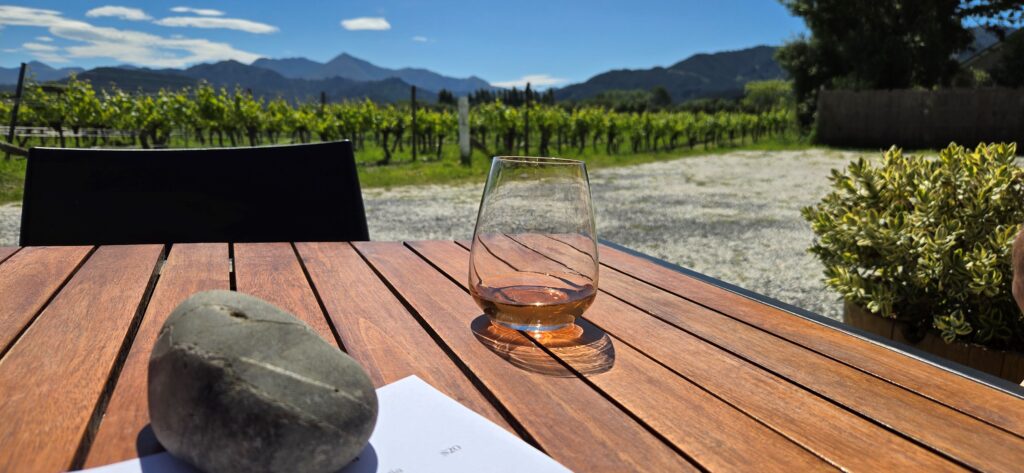
With over 27,000 hectares (68,000 acres) of vineyards, Marlborough is the largest of Aotearoa / New Zealand’s wine regions. It accounts for about ⅔ of the country’s entire wine production! If you enjoy wine – particularly sauvignon blanc – chances are you’ve tried or at least heard of this region.
Marlborough is most famous for its sauvignon blanc, which makes up over 80% of its wine production. Pinot noir comes in at a very distant second place. However, they also make other varieties – notably, pinot gris, chardonnay and riesling. A couple of wineries also make sparkling wine!
There are a few different ways you can visit Marlborough’s wineries:
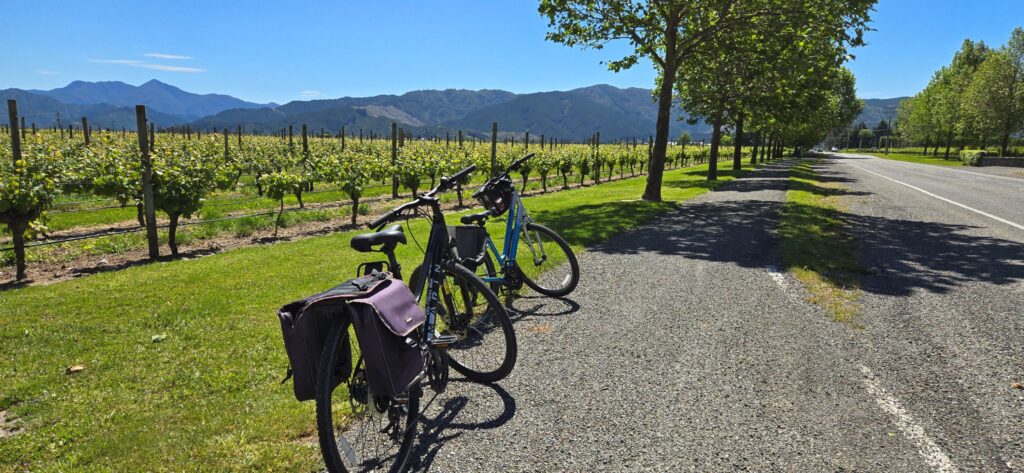
- Group or private tour by van: This option is one of the most popular ways to visit Marlborough’s wineries without having to worry about a designated driver. There are several options available with a quick Google search, or you can book through a platform like Get Your Guide.
- Self-guided bike tour: Cycling is my favorite way to visit a wine region, and I’m so glad we chose to visit Marlborough this way! While you don’t get to cover as much ground as in a car, I prefer the slower pace to better take in the scenery. We rented bikes through Wine Tours by Bike, which offers a free shuttle service from/to your accommodation. Or if you’re staying in a self-contained campervan, there is a small freedom campsite within walking distance (at the dog park). Just note that some of the bike paths are quite rocky.
- Self-drive: If you have your own transportation and a designated driver, self-drive is a great way to explore Marlborough. You can cover plenty of ground and design your own itinerary at your own pace.
If you want to visit any of the more famous or upscale wineries in Marlborough, make sure to make a reservation ahead of time.
All-in-all, if you’re a wine lover headed to New Zealand’s South Island, I’d say Marlborough is a must for your itinerary. Not to mention, it was named the country’s sunniest region in 2024, so you can (likely) enjoy some great weather, too!
Hawke’s Bay: Oldest New Zealand Wine Region
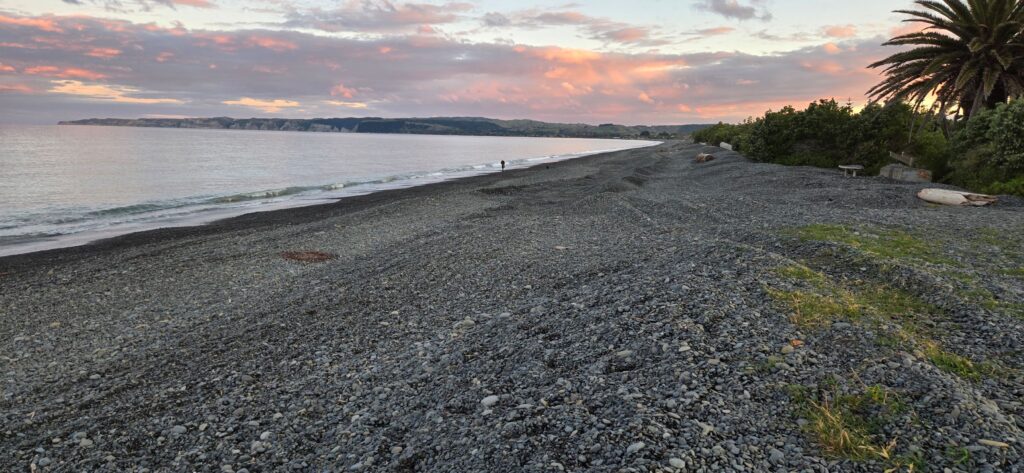
While Marlborough may be the largest Aotearoa / New Zealand wine region, Hawke’s Bay holds the record for the oldest and is very proud of their heritage. It’s also the most popular wine region on New Zealand’s North Island.
The wine makers in Hawke’s Bay will tell you their climate and soil in the southeast of the North Island allows them to produce a wide variety of different wines. However, they are best known for their chardonnay, sauvignon blanc and merlot. I’m a bit picky about my chardonnays, and I thought all the Hawke’s Bay chardonnay I tried was delicious. Because Hawke’s Bay makes a variety of reds and whites, you can of course also find some nice rose there.
You can visit Hawke’s Bay the same ways as Marlborough:
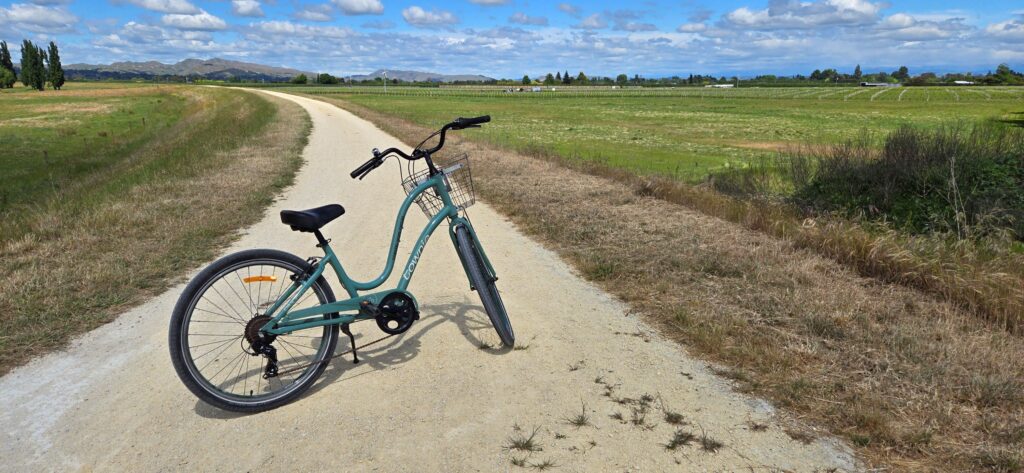
- Group or private tour by van: This option is one of the most popular ways to visit Hawke’s Bay’s wineries without having to worry about a designated driver. There are several options available with a quick Google search, or you can book through a platform like Get Your Guide.
- Self-guided bike tour: Cycling is my favorite way to visit a wine region, and I’m so glad we chose to visit Hawke’s Bay this way! The region of Hawke’s Bay is connected by several well-maintained cycling paths separated from the road. That makes cycling here a dream! While you don’t get to cover as much ground as in a car, I prefer the slower pace to better take in the scenery. We rented bikes through Coastal Wine Cycles. If you’re staying in a self-contained campervan, there is a freedom campsite within walking distance (and next to the beach).
- Self-drive: If you have your own transportation and a designated driver, self-drive is a great way to explore Hawke’s Bay. You can cover plenty of ground and design your own itinerary at your own pace.
If you want to visit any of the more famous or upscale wineries in Hawke’s Bay, I’d recommend making a reservation to be safe – especially in peak season.
Hawke’s Bay is also one of the sunniest regions in New Zealand, so you’re likely to find nice weather here as well!
Waiheke Island: One of the Most Easily Reachable of New Zealand’s Wine Regions
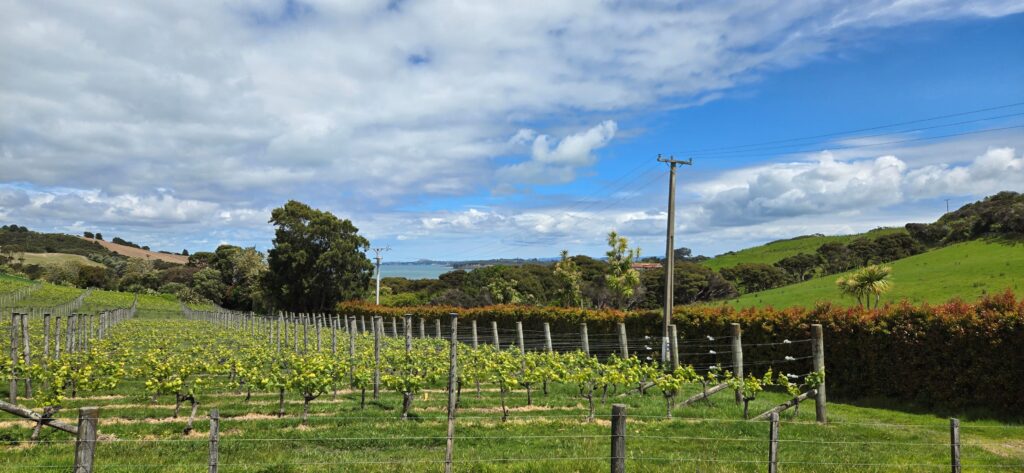
Waiheke Island is located about a 40-minute ferry ride from Auckland, Aotearoa / New Zealand’s largest city. Given its size, Auckland is a place many travelers to New Zealand will find themselves at one point during their trip.
One of the best things to do in Auckland is to take a day trip out to Waiheke Island. This small island reachable only by ferry is known primarily for its nature, wine and olive oil. It’s an excellent place to go wine tasting, especially if you’re short on time and already planning to visit Auckland. The wineries on Waiheke are best known first for their Bordeaux-style red blends, then their chardonnay. But their climate and soil allows them to make a variety of red and white wines.
To visit, just take a ferry from Auckland’s main terminal.
Then choose one of these methods for wine tasting:
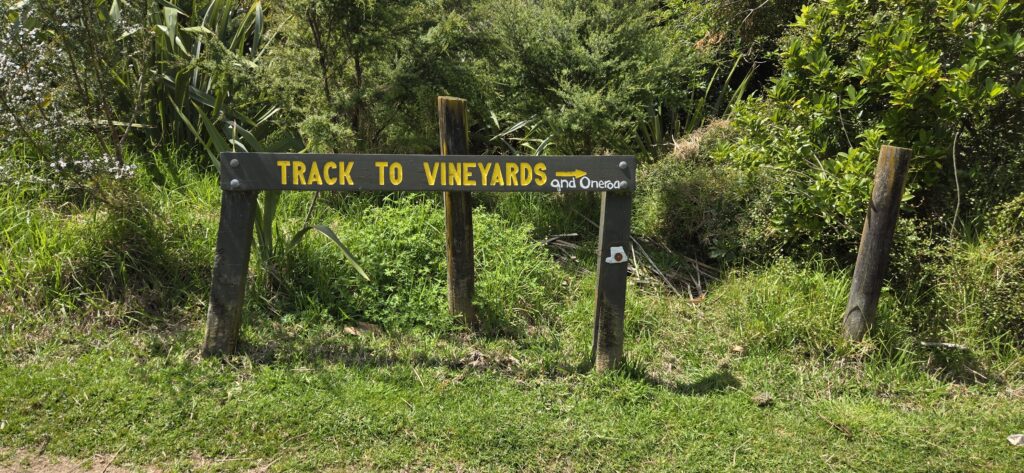
- Group Tours: This option is one of the most popular ways to visit Hawke’s Bay’s wineries without having to worry about a designated driver. There are several options available with a quick Google search, or you can book through a platform like Get Your Guide.
- Hop-on, hop-off bus: The Waiheke Island hop-on, hop-off bus is one of the most popular ways to get around the island. You can ride this bus and hop off at the winery stops for your tasting. Just book the bus ticket when you book your ferry ticket!
- Walking: When you get off the ferry in Waiheke, you’ll see a sign directing you to some nature trails and wineries. Follow the 20-minute trail through the woods to find the wineries on the other side. From here, you can easily visit at least three wineries, plus an olive oil maker, on foot. This is the way we chose to go wine tasting on Waiheke and enjoyed the relaxed pace and nature! Note that you’ll have to find a ride if you want to get to a winery on a different part of the island.
If you’re planning to visit other wine regions and nature areas in New Zealand, I wouldn’t necessarily call Waiheke a must-visit. I also found Waiheke more expensive than other New Zealand wine regions, which I believe is due to its size and limited availability. But if you’re looking for easy-to-reach wine tasting or a break from city life, Waiheke Island is nice.
Waipara Valley: A Growing New Zealand Wine Region

Located about 45 minutes north of Christchurch, Waipara is sometimes overlooked on a typical Aotearoa / New Zealand South Island itinerary. This New Zealand wine region is not as famous as some of the others on this list, but still worth a visit if you’re in the area and like good wine.
Waipara is best known for its pinot noir, chardonnay and riesling and has also won awards for its pinot gris. The drier climate in Waipara means the grapes have longer to ripen.
There are several recommended ways to visit Waipara Valley:
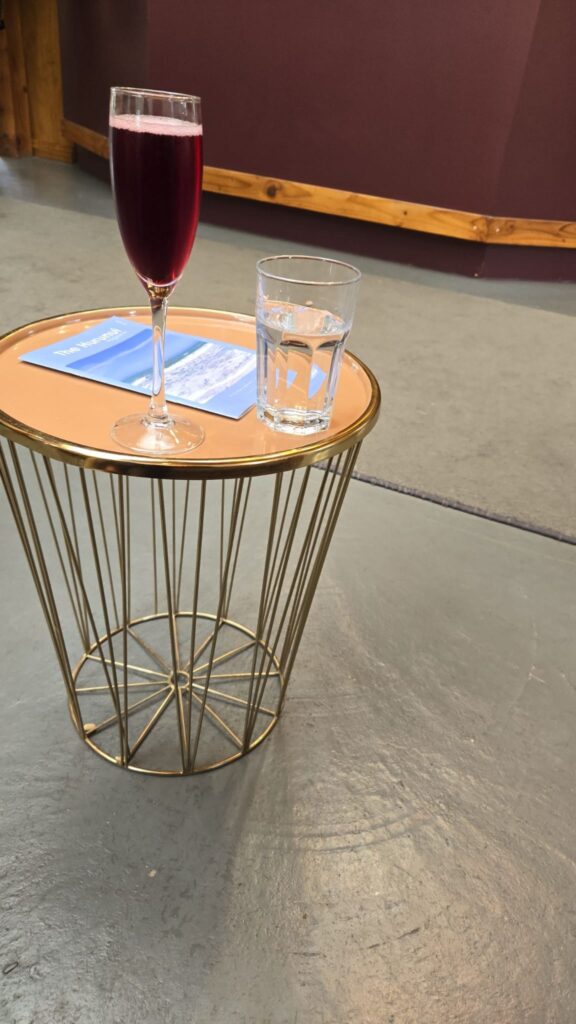
- Group or private tour by van: This option is one of the most popular ways to visit Waipara Valley’s wineries without having to worry about a designated driver. There are several options available with a quick Google search, or you can book through a platform like Get Your Guide.
- Self-guided bike tour: Cycling is my favorite way to visit a wine region, but unfortunately it wasn’t in the cards for my visit to Waipara. Still, there is a paved off-road bike trail that links some popular wineries.
- Self-drive: If you have your own transportation and a designated driver, self-drive is a great way to explore Waipara. You can cover plenty of ground and design your own itinerary at your own pace.
- Walking the Vineyard Trail: Starting from Glenmark Domain (which also has a freedom campsite for self-contained sprinter vans), there is a 14.5 kilometer (9-mile) trail that goes by several good wineries. Of course, you don’t have to walk the entire trail – you can just choose to visit one or two!
Due to time and weather constraints, we actually only visited one winery in Waipara Valley. But I do think they had the best tasting wine of all the wineries we visited across the country.
Other New Zealand Wine Regions to Consider

Unfortunately, I chose not to make my entire one month trip to Aotearoa / New Zealand about wine. (Why? I don’t know. I guess we all have to make sacrifices.)
That means I couldn’t visit every New Zealand wine region. Aside from the four I mentioned above, here are additional or alternative regions you could consider adding to your itinerary based on your schedule and what kind of wine you prefer.
North Island New Zealand Wine Regions:
- Northland: Located north of Auckland, Northland has the hottest (literally) wine region in New Zealand. Northland vineyards produce red and white wines, most notably chardonnay, syrah and pinot gris.
- Gisborne: On the east coast of the North Island, Gisborne also boasts plenty of sunshine and fertile landscapes that make for successful wine growing. The most popular wines here are whites – chardonnay, pinot gris and sauvignon blanc.
- Wairarapa: Near Wellington, this New Zealand wine region has a cooler climate that allows for a wide range of wines. They are best known for their pinot noir and sauvignon blanc.
South Island New Zealand Wine Regions:
- Nelson: Also located at the northern tip of New Zealand’s South Island, Nelson is in friendly competition with Marlborough for ‘sunniest region’ claims. Nelson is better known for its boutique wineries, and its most common varieties are sauvignon blanc and pinot noir.
- Waitaki: In the shadow of New Zealand’s Southern Alps, Waitaki has a cool, dry climate that results in producing a variety of grapes. This New Zealand wine region is best known for its pinot noir, with its pinot gris in a distant second.
- Central Otago: Central Otago is the southernmost wine region in New Zealand. It has a relatively extreme climate that makes for especially aromatic wine. The vast majority of this region produces pinot noir, but it also produces a few white wines like pinot gris, chardonnay and riesling.
Touring New Zealand’s Wine Regions by Bike
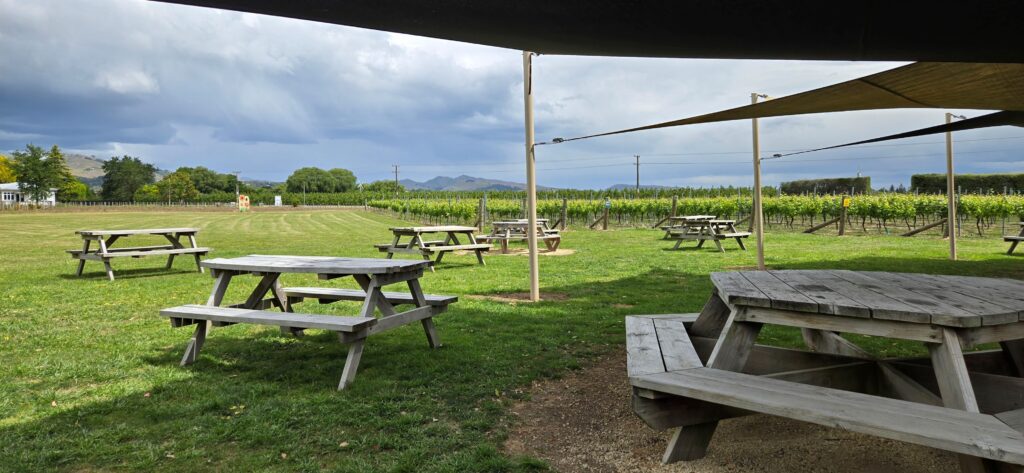
As you may have taken away from this post, touring Aotearoa / New Zealand’s wineries via bike is a common way to see these regions and taste some delicious wines. It is certainly my favorite way to go on a wine tasting tour.
If you do choose to visit any of New Zealand’s wine regions via self-guided bike tour, here are a few things to know.
Bike Rental
If you don’t have your own bike (and I’d assume if you’re an average tourist to New Zealand, you don’t), you will have to rent one. The regions with good bike paths typically have a few options for bike rental shops. In my experiences, these shops also provide maps with nearby wineries and advice on the best ones to visit. Cost to rent a bike seemed to start at around $55 NZD for a standard adult bike.
Biking Laws
You are required to wear a helmet while on a bike in New Zealand by law. If you fail to do so, you could get fined. This law applies to children as well. DUI laws do not apply to non-motorized bicycles.
Drinking Responsibly
“The bike paths are nice, so the biggest danger you face today is alcohol.”
The man at Coastal Cycles said this to us before we left his shop with our bikes, to emphasize the importance of drinking responsibly. While you cannot get a DUI on a bike in New Zealand, you can still do harm to yourself or possibly others if you imbibe too much before cycling. If you find you’ve accidentally overconsumed, most bike rental shops can help collect you and the bike so you don’t have to ride it.
Hope you enjoyed my tips for choosing a New Zealand wine region! Which would you visit?
Pin this post to save it for later.

